PART 2. «Implementation of the complex restoration of the Church of the Transfiguration of Kizhi Pogost»
 @kizhi
@kizhi
SECTION II. «Preparatory period. 2002-2008». Implementation of works of preparatory period in 2009
The report given below concerns the work done for maintenance and protection of Kizhi Pogost and a complex restoration of the Church of the Transfiguration of Our Lord on Kizhi Island as to the end of 2009. The main emphasis is made on the measures taken in 2009. The preparatory works that had been done before are expounded in the similar reports for previous years (2004–2007) in detail. The given report includes principal sections «Main Stages of Works on the Restoration of the Church of the Transfiguration on Kizhi Island and their Fulfillment vs. Time.1999–2014. The situation described as to the end of 2009»:
SECTION II. «Preparatory period. 2002–2008»;
SECTION III. Implementation of the main restoration works (2007–2014).
The sections are supplied with graphic materials and photos that provide insight into the progress and results of the work done.
It is necessary to mention that a considerate volume of preparatory works has been finished, and the stage of the restoration proper started in 2009. The successful completion of all preparatory works created favorable conditions for starting restoration of the church log walls, refectory, and reconstruction of the foundation. The measures taken in 2009 as well as the results are given in all details in different sections of the present report. They are of great interest to expert-restorers because this is both first experience of such work and, the restoration object is the Church of the Transfiguration of Our Lord i. e. a unique monument of wooden architecture mentioned in the World Heritage List of UNESCO. The Commission of the Ministry of Culture of RF and Federal Organization «Росохранкультура РФ» visited Kizhi Island in April, 2009, examined the state of affairs in restoration of the Church of the Transfiguration and approved the works done. On the 1st of July 2009, the Ministry of Culture of RF after several meetings issued a permission to start first stage of restoration works.
Measures in section I «Preliminary works» as well as subsections II.1-II.9 in section II «Preparatory period» had been completed before and were described in our reports for the previous years. This is why the present report includes only the measures taken in the reporting year i.e. 2009.
SUBSECTION II.10 «Development of working documents for completion III and IV stages of Complex Restoration. 2004-2014»
Elaboration of working documents for completion III and IV stages of Complex Restoration was going on. Chief designer «Spetsprojectrestavratsiya», Saint-Petersburg, (Chief architect is Mr. Rachmanov V. S.) continued project works in collaboration with subcontracted organizations. These project works include reconstruction of the foundation, restoration of floor (XVIII-XIX centuries), reassembly of the church log walls, restoration of window and doorway elements.
They exercised field and engineering supervision of mounting metalwork for lifting and suspension of the engineering restoration tiers of the church log walls and transverse foundations for the structures supporting lifting equipment. On the whole, design organizations did their work satisfactorily, but the effective field supervision of the works in progress was quite difficult because Kizhi Island is far from Saint-Petersburg and system of payment to designers was too sophisticated. This is why the questions of adapting manufactured metalwork to real-life conditions of assembly on the site were most often decided by the contractor SKF «Alekon» in collaboration with the customer i. e. representatives from the Museum department of restoration, and then approved by the designer’s representatives; the changes made were included in the production project.
Operational experience in 2009 proved once again that the designer’s representatives should be present on the site, especially during the completion stage of the installation and when adjusting the system of lifting and suspension of the engineering restoration tiers of the church log walls. This is critical for taking quick expert decisions on the complicated technical issues that arise during the work. The completion of the installation and adjustment of the equipment for lifting and suspension of the church log walls is the most important restoration event on which depends the successful implementation of Complex Restoration on the whole. This is why the attitude to the issue of field and engineering supervision should be the most serious, taking into consideration that the question under discussion is the object of the World Heritage of UNESCO, a genuine gem of Russian wooden architecture.
SUBSECTION II.11. «Development of fire protection technologies for Kizhi Pogost Monuments in 2009»
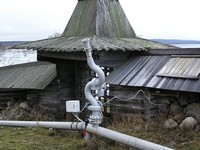
Two remote-controlled nozzles on the Kizhi Pogost have been replaced this year.Besides that, a year-round maintenance of fire-protection system, alarm system and video surveillance has been performed. All of the monuments on the Pudozh exhibition sector were equipped with fire alarm systems. These systems use a radio channel to inform Central round-the-clock guarding post on Kizhi Pogost about emergency situation. These buildings on the Pudozh exhibition sector were adapted for restoration workshops to restore the iconostasis of the Church of the Transfiguration.
The projecting of a nighttime supervisory control system for guarding the area around Pogost has been started. This system is based on thermal imaging devices of home manufacture. The production project is planned to be completed in 2010, and it is supposed to purchase and install this equipment around Kizhi Pogost in 2011.
And the main thing is, the project of reconstruction of the existing fire fighting equipment around Kizhi Pogost has been fulfilled. This project implies the construction of a year-round pumping station for the fire fighting equipment on the lakeside. The existing pumping station on the «Vjun» fire ship operates only in frost-free season. Water will be taken from Lake Onega. Fire extinguishing agent is supplied as 200 liters per second. The equipment layout on Pogost is also being improved: 14 fire-fighting robots are installed, and these robots may be program controlled, remote controlled or controlled manually. All fire-extinguishing means (i. e. fire ship «Vjun», piers, a landing stage, accessory buildings, and electric service panel for switching equipment) are to be removed from the eastern part of Pogost after the completion of construction works. In 2010, the project will be submitted for endorsement, and then in 2011 the construction works should be started and completed in 2012.
SUBSECTION II.12. «Construction of a restoration center for the iconostasis of the Church of the Transfiguration».
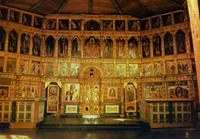
Pudozh sector of the museum was chosen for the location of the restoration center. The development of engineering infrastructure of this sector was going on in the reporting year with the purpose of adaptation of existing monuments of architecture (peasant houses) for restoration workshops. In this connection, the following measures have been taken:
- the adaptation of existing premises for restoration workshops and supplying with all necessary equipment and stock;
- living accommodations for iconostasis restorers for summer time have been equipped with the necessary facilities (for 5 persons);
As a result, it is possible to say that the conditions for restoration of the iconostasis have been ensured, and there are no obstacles to their implementation. Restoration works were going on in 2009. The contract was made, and a team of restores from Moscow was successfully working in the premises of the Pudozh exhibition sector in summer. They were restoring a carved gilded frame of the iconostasis.Planned work was completed. A part of restoration works is planned for winter 2009–2010; some small parts of a carved gilded iconostasis were taken to Moscow (15 containers).
SUBSECTION II.13. «Manufacture of the equipment for lifting to suspend engineering restoration tiers of the Church of the Transfiguration»
All lifting equipment necessary for the suspension of the Church of the Transfiguration was constructed in 2009.Construction works were completed both in the assembly department of the contractor SKF «Alekon» in Saint-Petersburg and metalware department near the Kizhi Pogost. Some part of the equipment was purchased in line with the contract with SKF «Alekon» from suppliers in Saint-Petersburg (jack screws). The manufactured equipment and materials were delivered to the island of Kizhi and applied for the lifting and suspension equipment. Thus, the works under subsection II.13. were completed in 2009.
SUBSECTION II.14. «Assembly of the lifting equipment and suspension of the engineering restoration tiers of the church, mounting of transverse concrete foundations»
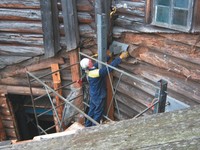
The volume of work stipulated in the contract for 2009 includes the following:
- laying additional transverse concrete foundations in the church annexes for the supports of suspension system under extra project 181/09-КЖ issued by company «Stroyrekonstruksiya», Co ltd in 2009;
- mounting metal constructions for suspending log walls of the main i. e. lower octagon and log annexes both outside and inside the church, with the whole metal construction resting on the prepared transverse concrete foundations (basic ones in 2008, 10 pieces, and additional ones in 2009, 20 pieces) under project 286/06-КМ;
- adjustment and testing of the whole lifting system and, suspension of the engineering restoration tiers of the monument;
The installation of rather heavy equipment that features large overall dimensions in the straitened conditions inside the church requires outstanding qualifications of the specialists. Moreover, as the result of unevenness of the church log walls, many of the equipment units had to be installed in the following way: first, the individual master form was taken, and the units were fitted into this form, and only afterwards these units could be installed on the site. Installers from SKF «Alekon» Co Ltd have quite the appropriate qualification and work experience to meet the requirements of the above-mentioned conditions.
At the same time, similar constructions for holding log walls were installed symmetrically on the exterior diagonal walls and some exterior walls of log annexes, which defined a final position of transverse foundations for supports of the lower octagon. Twenty transverse beams for concrete foundations under projects 81/09 КЖ and ППР 151/08 have been produced during this summer.Supports of the equipment for lifting and suspension of log walls of the lower octagon were mounted atop foundations after 7 days of curing according to technological requirements.
Upon the completion of installation works, the system was adjusted and put into operation with the assistance of project developers. Then, the upper three engineering restoration tiers were lifted successively, which made it possible to unload the lower octagon to 150 tons. After the lifting procedures, church log walls were fixed in a new position. Thus, the volume of work planned for SKF «Alekon» Co Ltd in 2009 was fulfilled, although the commencement of works was seriously delayed (until July, 20) due to late preparation of the permission to start restoration works.
The works were performed by the team of installers headed by N. N. Bardashev under the leadership of the chief engineer M. Y. Nikishin. Meanwhile, all of the preparatory and completion works were performed by the Kizhi Museum Carpenter’s Center (Chief is Mr. Kovaltchuk A. L.) Direct supervision of works on the site and engineering supervision was done by the Chief engineer of the Department of Restoration Kuusella A. S. on behalf of the Kizhi museum. The engineering supervision was also done by the project authors: Chief engineer SKF «Stroyrekonstruksiya» Mr. Rasha I. K. and the Main specialist of the company Ms. Dachnovskaya N. A.
The conservation of site was accomplished by Carpenter’s Center after completion of works planned for 2009; constructed foundations and affected grounds under the church were sheltered and heat insulation was provided.
The completion of works on installation of the equipment for lifting and suspension will make it possible to disassemble the lower VII-th restoration tier, deliver it to the restoration complex and reconstruct the whole foundation in 2010.
SECTION III. «The main restoration works (2007-2014)». Implementation of the main restoration works in 2009.
While the measures planned for the preparatory period were carried out, the museum Carpenter’s Center adopted the Restoration Complex and performed an experimental restoration of the granary from the village of Peldozhi, some components of the original church floor dating from the XVIII-XIX centuries were restored as well; the contractors performed the reconstruction of church foundations, disassembled the church refectory and restored carved gilt-frame of the iconostasis.
SUBSECTION III.1. «Adoption of the Restoration Complex. Acquisition, installation and adjustment of the woodworking machinery for restoration»
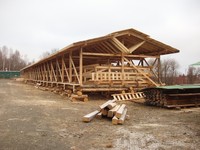
As a part of preparatory work for the restoration of the Church of the Transfiguration, a considerable volume of work was done on the adoption of a newly built Restoration Complex, and this work had been almost completed in 2007-2008 (see reports for these years).
The production project of improvement of power supply for all the consumers of 1st rank (i.e. those of primary importance) within the Restoration Complex has been developed during last years. Electrical equipment was purchased and installed on the site. After the adjustments, round-the-clock power supply was provided for woodworking equipment, cranage, resistance heating of personal service rooms, fire-fighting equipment of workrooms, and electric lighting. This is a power supply that works independently from of the primary power which is located on the mainland and works unsteady. Thus, the restoration works may be performed in the Restoration Complex twenty-four-hours and all year round. According to the work production plan, the roofed storage for the restored logs of the Church of the Transfiguration was built on the territory of the Restoration Complex between the assembly department and pumping station for fire protection in 2009. This storage facility will make it possible to use the area of Restoration Complex in the optimal way, i.e. relieve departments and storehouse of the Complex from the intermediate storage of the parts that has just entered for the restoration or has been restored before they are used in the further stages.
In summer, 2009, ventilating holes were made underneath the sidewalls of the assembly department and storage of the restored parts to improve airing of the workrooms and prevent condensing on the inside of the department’s metal roof that lacks heat insulation.
SUBSECTION III.2. «Experimental restoration of the granary from the village of Peldozhi in the Restoration Complex»
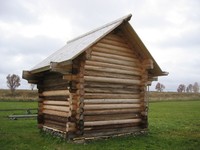
Log walls of the granary built in the XVIII-th century and included in the list of Kizhi Museum monuments is almost identical in age, method of cutting, degree of preservation and condition of joints to the log walls of the Church of the Transfiguration, especially 2 nd and 3 rd octahedrons.
Logs in both of the buildings are noted for a good state of preservation on their inside surface (i. e. facing the interior of the monument), meanwhile their external surface is almost disrupt or even ruined in some parts. The external surface of logs located in the south-eastern portion is especially damaged because these logs are most liable to sousing from the rainwater that trickles down the walls and to slanting rains during cross winds, and besides that, they are exposed to intensive solar irradiation. As the result of all the reasons mentioned above, sapwood on the external log surface started to crack, water penetrated into the cracks and rather deep tubular mould generated in these parts of the logs; this is quite often the case that water was running all along the logs penetrating into the log joints and the log ends protruding from the corners which increases logs rotting.
The granary was disassembled, the logs were carefully inspected, and afterwards restoration techniques were developed for each of the logs. The conditions of the Restoration Complex made it possible to use different approaches to methods of restoration. At the same time, various well-known and new technologies of woodworking applied in log restoration were used and tried: lengthening, assembly on long connectors (wooden rods), putting insertion pieces and grooves applying glue junctions of phenolresorcin glues, preliminary assembling of the log walls inside the assembly department of the Restoration Complex.
The experimental restoration of the granary proved in practice the correctness of the chosen restoration technique for logs and reassembly of the log buildings.Besides that, it gave the opportunity to gain work experience of performing such tasks, and this experience helps to prepare for the restoration of log walls of the Church of the Transfiguration and have well-prepared, qualified carpenters-restorers at hand. The process and results of the restoration done on the granary from the village of Peldozhi are stated in the report on the restoration which is available in the archives of the Kizhi Museum. In April 2009, the restored granary was set back on the exhibition.
The results of the experimental restoration of the granary using advanced technologies will be presented to experts for approval; their conclusion about the quality of the work done, remarks and suggestions will be assumed as a basis when it comes to taking final decision about the restoration technology for log walls of the Church of the Transfiguration. The experience gained during restoration works on this object will be taken into consideration, too. The report on the restoration of the granary was translated in English in January, 2009 and sent to experts for consideration.
SUBSECTION III.3. «The restoration of original floors of the XVIII-XIX cc.»

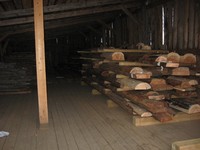
The restoration of the original floor dating from the XVIII-XIX c. was going on in 2009. The work was done step-by-step and included the following:
- Cleaning the altar, church proper, refectory and solea portions of the floor from dust and surface contamination with a high-pressure apparatus. The cleaning was done during frost-free season by air-drying. An average water discharge was 35–40 liters per component. Moist factors before and 7 days after the cleaning did not vary in more than 2%.
- The restoration works were done on some elements of altar and solea floors, northern and southern log annexes, central portion of the church proper and included the following:
- extracting defected elements;
- producing and fixing insertion pieces.
- Manufacturing, adjusting and fixation of insertion pieces for joining sawed elements and structural timber lengthening for the components that have losses. The fixation of insertion pieces on the restored elements was done with adhesive composition «КАСКОСИНОЛ 1714/2520» using additional pegs of birch wood. Insertion pieces for lengthwise fixation were produced for the elements that are supposed to be jointed and their total length is more than 7 m; these insertion pieces were fixed from one side of the defected elements.
- Crack filling followed by polishing to obtain the ground for painting: it was done for the elements that feature cracks, pinchers, and alike minor defects.
- Photos of all the restored elements of the floor half-beams were taken from four sides with the massive plotting board on the background.
- During the restoration they kept the record of the works done, characteristics of the restored elements, restoration material and tools used, the succession of the restoration procedures.
- The insertion pieces fixed into the floor components have labeling «ПЦ» (i. e. Carpenter’s Center), date of the restoration and initials of the person who performed the work.
- The restored elements of the floor are stocked in the storage area, detailed tables and maps of stacking are made. The lower tier is set on the antiseptically treated beams 15×15 cm.placed with 1 m spacings; The rows were interlaid with antiseptical poles (diameter 7–9 cm) treated with sandpaper.
All the floors have been restored as of the 1 st of December 2009. The restoration of the original floor is almost completed.
SUBSECTION III.4. «Disassembly of the church refectory; transportation to the Restoration Complex. Restoration, fit-up assembly, assembling with VII-VI restoration tiers as a whole»
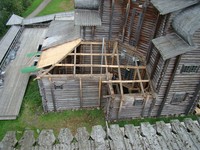
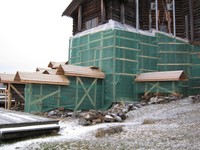
Restoration of the Church of the Transfiguration implies disassembling of the refectory that links to the church as a separate stage of works; this is supposed to be done aside from the disassembling of the whole church which is accomplished by the means of special lifting equipment.Constructive features of the refectory, numerous repairs that had been previously made, loss of the most of the links to the church log walls make it possible to disassemble the refectory in a traditional way, which considerably saves time and money.
Disassembly of the refectory was done in September-October 2009 according to the work production plan developed by «Spetsprojectrestavratsiya» Institute: «Disassembly of the refectory of the Church of the Transfiguration. I-st stage of work». The work was done by a team of restorers (8 persons) from Karelia, «Restavratsiya» Co Ltd, the town of Sortavala. Permission to start works (№ 05–4/141 as of July,1, 2009) was acquired in advance on the basis of tender; Government Contract № 29/09 as September, 3, 2009.
«Carpenter’s center» of the Kizhi Museum had been working on the refectory earlier. In 2007, floors of the XVIII and XIX cc. were taken to pieces and brought to the Restoration Complex; the porch was also disassembled and stored.Corbels of the porch were covered with a metal case to prevent from moisture. Logically, the next step was disassembly of the log walls, roof and floor beams.
Main works done by the contracting organization in 2009:
- sign making of the refectory parts;
- dismantling of the fire fighting equipment, video surveillance and electric lighting;
- removing roof planks, removing roof timbers and binding rafter;
- removing upper logs of refectory walls, window and doorcases;
- removing floor beams of the refectory;
- removing stone infillings of the foundations and adjusting lifting jacks under the lower rows of logs;
- removing lower logs of refectory walls;
- transportation, cleaning and storing removed parts in the Restoration Complex;
- ground leveling operation and construction of drainage pipes from under the foundation of the refectory;
- removal and storage of the soil on the Restoration Complex;
- measures of conservation: setting supports under the rows of logs of church refectory and constructing protective roofs above the remaining walls;
- preparation of the storage facilities for storing restored components of the refectory;
All of the works were done in compliance with the developed project; daily engineering supervision was implemented by the experts of the Kizhi Museum, field supervision was done by the project developer. The opportunity to remove some more wall logs presented itself in the course of works. These works were done by the contractor. All the parts that have been removed are stored in the Restoration Complex in a special storage and prepared for restoration which will be done by the «Carpenter’s center» of the museum in wintertime.
Five logs were selected and thoroughly inspected in December 2009. The photos of this log were made from all the sides, necessary measurements were made as well as the drafts describing log’s condition and restoration drafts. In this way, first set of original material was prepared for restoration.
It was not possible to remove some of wall logs of the refectory, and they were covered with special protective roofs. These logs are securely suspended and fixed by the means of special equipment.
The walls of the church proper located in the refectory’s section are in good condition; they were covered with special material to protect from precipitation and insolation. Extra emergency exit that leads to the engineering flooring was made on the 1 st floor from the window of the northern annex.
The remaining part of the refectory will be removed during the disassembly of the two lower restoration tiers. The experience of works that had been previously done during the disassembly of the original floors and church porch makes it possible to estimate the volume of the material left and percentage of the refectory parts. This is approximately 10–15% of the whole volume, i. e. 85–90% is being restored at present.
The reassembly of the refectory on the original place will be accomplished simultaneously with the lower restoration tier on the new foundation and modified design elevations. Preassembly of the lower part of the refectory together with the church proper will be performed in the Restoration Complex.
The works for this subsection III.4. are completed as 20%. Date for subsections III.5-III.6 is not due yet.
SUBSECTION III.7. «Reconstruction of the foundation of the Church of the Transfiguration»
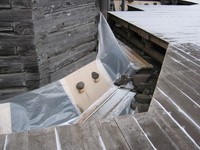
Section II of the present report describes the implementation of works on laying foundations for supports of the equipment that suspends engineering restoration tiers. According to the design concept, these transverse foundations will be integrated into the one-piece strip foundation and perform two functions:
- acting as supports for the studs of suspension equipment;
- preventing concrete foundations of the metal framework built in 1982 from sliding down to the trench when it comes to laying rubble concrete strip foundation under the freezing point.
A production project of transverse foundations laid in the church annexes for the studs (supports) of suspension equipment was developed in 2009 by «Stroyrekonstruksiya, «Co ltd, under the contract with the Kizhi Museum. These foundations were laid, and supports for suspending church log walls were installed. The total amount of the foundations laid in 2008–2009 equals to 32. (See draft «The layout of foundations for the studs of suspension equipment, «2009, the as-build).
Thus, works on transverse foundations is the first stage of the reconstruction of original strip foundation, and it continues in 2010. Date for sections III.8-III.9 is not due yet.
SUBSECTION III.10. «Restoration of carved gilt-frame of the Church iconostasis».

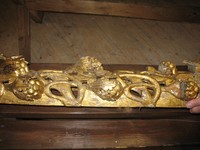
I. Working restoration.
In 2009, the Kizhi Museum has completed a long period of preparatory works and started the restoration of the golden frame of the iconostasis of the Church of the Transfiguration.
The funds were provided by the state budget according to «Plan of measures for maintenance and protection of Kizhi Pogost monuments (Kizhi Island, the Republic of Karelia) and development of infrastructure of the Kizhi Open-Air Museum of Architecture and Cultural History» (approved by the decree of the Government of RF № 1633-р as of 7.11.2008).It was supposed that 3 600 000 RUB must have been drawn since 20.05.2009 until 30.06.2010, and 2 500 000 RUB of this amount in 2009.
Competitive tendering for a contractor was organized by the museum in April-May 2009. As a result, the contractor for the first stage of restoration is the Regional Department of Restoration (МНРХУ, Moscow). The contract between the Kizhi Museum and the Regional Department of Restoration (МНРХУ) continues for more than 30 years. Experts from the Regional Department of Restoration (МНРХУ) performed conservation of the gilt coating of the iconostasis frame in 1970–1980, restored icons of the Church of the Transfiguration, took part in development of the methodology for conservation of the gilt coating of the iconostasis frame in 1990-s. Today the Regional Department of Restoration (МНРХУ) is one of the leaders in restoration in Russia.
The Regional Department of Restoration (МНРХУ) started restoration works in June 2009.
The lower tier of the iconostasis is stored in 10 panels. («Кижи» КП 2834/1–10). Panels are rectangular; they have a cornice and base board laid on corbels along the sides. A cartouche is set in the center of the panel. There are two kinds of superimposed carvings: blind one painted with silver and fretwork with gilding. Background is green, white, and blue. Total area of the surface is 53, 45 sq. m.Surface of wood is 21, 9 sq. m. Gilded surface is 24, 6 sq. m. Other painted surfaces comprise 6, 95 sq. m.
The transportation of the basic components from the island of Kizhi to the contractor’s restoration workshops is hardly possible due to a big size and unsatisfactory condition. This is why the most volume of the work was supposed to have been done on the island of Kizhi. Two restoration workshops for six restorers were arranged on the island of Kizhi and the accommodation for five persons. The works on the island were performed until cold weather and stopped in the beginning of October. Fifteen superimposed carvings were transported to the Regional Department of Restoration (МНРХУ) to continue restoration in wintertime. The works planned for 2009 have been completed.
Several interrelated problems revealed themselves during the restoration, and these problems need a solution:
- During the restoration, it turned out that the condition of gilding requires much more complicated methods of restoration than it was supposed. Thus, it is necessary to take into consideration the increasing volume of works and their cost as well as the prolongation of restoration period.
- The experts of the Kizhi Museum had stressed the importance of restoring carvings and woodwork more than once before the restoration works actually started. However, the necessity of wood restoration and work of restorers were not taken into consideration in preliminary calculation of works done gratuitously by the Regional Department of Restoration (МНРХУ) in 2007–2008, and thus funds have not been allocated. The very essence of the problem is that skilled experienced carvers are missing in many of the restoration centers in Russia and the Regional Department of Restoration (МНРХУ) as well. Some measures were taken in this connection. Three wood restorers of the Kizhi Museum have been studying in the State Institute of Restoration, The Russian Museum of Cultural History, in Grabar’s All-Russia Restoration Center during last five years and were admitted to restoration works. Their trial work has been approved by the Regional Department of Restoration (МНРХУ). Museum restorers of paintings developed damage statements for the lower and local tiers of the iconostasis frame during 2009; the damage statement for the festive tier is almost completed. Thus, museum restorers of paintings can take part in current restoration works and the subsequent monitoring of the iconostasis condition since 2010.
- The restoration of a gilt carving is quite a complicated work, and the schedule of works is very strict, the first of the two mentioned points implies that more restorers are needed, and the second one that these works must be done all year round; The accommodation for five persons was arranged in the annex to Belyaev’s house, and in the smithy of the Pudozh exhibition sector. However, total accommodation area is 20 sq. m. which is hardly enough for five experts in summer time and cannot be used all year round. The only way to solve the problem of insufficient living area is purchasing at least two accommodation modules. Otherwise, the restoration may last decades or more.
II. Development of the monitoring system for the iconostasis of the Church of the Transfiguration of Our Savior.
«Programme for maintenance and protection of Kizhi Pogost monuments…» (by the decree of the Government of the Russian Federation as of 07.11.2008 № 1633-p) stipulates «Development of the electronic database for monitoring of the iconostasis of the Church of the Transfiguration of the Kizhi Pogost». Dates of performance: 2009–2010. Funds allocated by the Federal budget: 200 000 RUB (100 000 RUB yearly). When fulfilling this point of the plan, IT (information technologies) department of the museum searched out and analyzed possible ways of the implementation. The cheapest and the most acceptable solution is purchasing the programming module «Restoration» developed by «ALTSOFT» Company as an application for «КАМИС» programme. Programming module «Restoration» was made as the requirements specification for the Hermitage Museum; it was tried in use and received recognition. The cost of programming module «Restoration» is about 300 000 RUB. The museum managed to find missing funds. The installation of the programming module «Restoration» and training of the personnel will be accomplished in the near future.
The museum is ready to start development of the database for the iconostasis of the Church of the Transfiguration of Our Savior in the first half of 2010 already.
It is necessary to stress that the programming module «Restoration» requires some adjustments to meet the needs of the museum and specificity of the iconostasis. For this reason, financing of works on software upgrade must be foreseen for 2010 and next years.
SUBSECTION III.11. «Restoration of the iconostasis paintings in the Church of the Transfiguration»
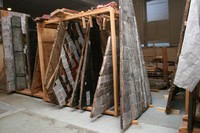
The icons were removed from the iconostasis of the Church of the Transfiguration for storage in 1980; their condition is controlled by the museum custodians. The icons are restored when needed, and this guarantees their safekeeping; in some cases, only measures of preservations will be needed to keep icons in good condition. The volume and nature of these measures will be clear in the mid-term of the restoration i. e. closer to the very moment of placing into the iconostasis frame.
For reference: it is obligatory that works on conservation of icons of such a value are performed once in 10–15 years or, even oftener for some of the icons. Icons of the Local tier obviously need some restoration. Museum restorer Kuusela N. S.completed a study course of «Restoration of the Old-Russian Paintings» in Grabar’s All-Russia Restoration Center in November, 2009, and this event opens up the opportunity to raise the level of attainments and performance quality of promising young specialists, who are ready to help in restoration of the iconostasis paintings in the Church of the Transfiguration when the time comes.
